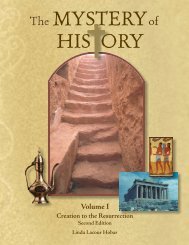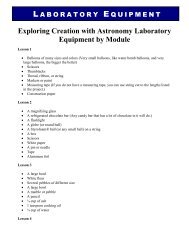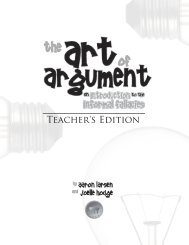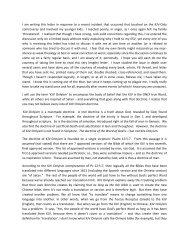JS British History Key.pdf
JS British History Key.pdf
JS British History Key.pdf
Create successful ePaper yourself
Turn your PDF publications into a flip-book with our unique Google optimized e-Paper software.
First printing: March 2012Copyright © 2012 by James P. Stobaugh. All rights reserved. No part of this book may be used or reproduced inany manner whatsoever without written permission of the publisher, except in the case of brief quotations inarticles and reviews. For information write:ISBN-13: 978-0-89051-645-4Cover design by Diana Bogardus.Interior design by Terry White.Master Books®, P.O. Box 726, Green Forest, AR 72638Master Books® is a division of the New Leaf Publishing Group, Inc.Unless otherwise noted all images are from shutterstock.com, Library of Congress (LOC-image), andWikimedia Commons. All images used under the Creative Commons Attribution-Share Alike 3.0 Unportedlicense (CC-BY-SA-3.0) are noted; license details available at creativecommons.org/licenses/by-sa/3.0/.Scripture quotations taken from The Holy Bible, New International Version®, Copyright © 1973, 1978, 1984,2011 by Biblica, Inc. TM Used by permission of Zondervan, All rights reserved worldwide.Please consider requesting that a copy of this volume be purchased by your local library system.Printed in the United States of AmericaPlease visit our website for other great titles:www.masterbooks.netFor information regarding author interviews, please contact the publicity department at (870) 438-5288This book is dedicated to this new generation of young believers whose fervor and dedication to thepurposes of the Lord shall yet bring a great revival. Stand tall, young people, and serve our Lord withalacrity and courage!
How TO USE Your Teacher GuideHow this course has been developed:1. Teacher: this allows one to study the studentobjectives with each chapter, providing theanswers to the assignments and the weekly exam.2. Chapters: this course has 34 chapters (representing34 weeks of study).3. Lessons: each chapter has 5 lessons each, takingapproximately 20 to 30 minutes each. There will bea short reading followed by critical thinkingquestions. Some questions require a specificanswer from the text where others are moreopen-ended, leading the student to think “outsidethe box.”4. Weekly exams: the final lesson of the week is theexam covering the week’s chapter. Students are notto use their text to answer these questions unlessotherwise directed.5. Student responsibility: Responsibility to completethis course is on the student. Students are tocomplete the readings every day, handing theirresponses to a parent or teacher for evaluation.Independence is strongly encouraged in thiscourse designed for the student to practice independentlearning.6. Grading: A parent or teacher can grade assignmentsdaily or weekly, and keep track of this intheir files. Assignments with answers are availableat the end of each chapter.Throughout this book you will find thefollowing components:1. Narrative Background: background on theperiod.2. Critical Thinking Questions: questions basedroughly on Bloom’s Taxonomy.3. Concepts/Generalizations: terms, concepts, andtheories to be learned.4. <strong>History</strong> Maker: a person(s) who clearly changedthe course of history.5. Historiographies or Historical Debate: anexamination of historical theories surrounding aperiod or topic.6. World View Formation: An overview of historicalunderstandings of who God is. There is also asubsection where we examine important thinkersof the period/topic.7. <strong>History</strong> & World View Overview: an overview ofworld views.What the student will need:1. Notepad: for writing assignments.2. Pen/pencil: for the answers and essays.3. Weekly Exams: available at the back of teacherguide or as a free download at:nlpg.com/britishhistoryexamAbout the AuthorJames P. Stobaugh and his wife, Karen, have home schooled their four children since 1985. They have a growing ministry,For Such a Time As This Ministries, committed to challenging this generation to change itsworld for Christ.Dr. Stobaugh is an ordained pastor, a certified secondary teacher, and an SAT coach. Hisacademic credentials include: BA, cum laude Vanderbilt University; Teacher Certification,Peabody College for Teachers; MA, Rutgers University; MDiv, Princeton TheologicalSeminary; Merrill Fellow, Harvard University; DMin Gordon Conwell Seminary.Dr. Stobaugh has written articles for magazines: Leadership, Presbyterian Survey, PrincetonSpire, Ministries Today, and Pulpit Digest. Dr. Stobaugh’s books include the SAT PreparationCourse for the Christian Student, the ACT Preparation Course for the Christian Student, as wellas American <strong>History</strong>, <strong>British</strong> <strong>History</strong>, and World <strong>History</strong> high school curriculum.
ContentsPreface................................................................................................................................................................................... 61. Early England: Part One.............................................................................................................................................. 72. Early England: Part Two............................................................................................................................................ 113. Anglo-Saxon Invasions.............................................................................................................................................. 144. The Norman Conquest.............................................................................................................................................. 175. Henry VIII and the English Reformation............................................................................................................... 206. Elizabethan Age: Part One........................................................................................................................................ 237. Elizabethan Age: Part Two........................................................................................................................................ 278. The Golden Age......................................................................................................................................................... 309. The Early Stuarts........................................................................................................................................................ 3310. The English Civil War............................................................................................................................................... 3611. The Commonwealth.................................................................................................................................................. 3912. The Restoration.......................................................................................................................................................... 4213. The Glorious Revolution........................................................................................................................................... 4514. The Oranges, Stuarts, & Hanovers........................................................................................................................... 4815. Whigs and Tories....................................................................................................................................................... 5216. European Wars........................................................................................................................................................... 5517. <strong>British</strong> Empire............................................................................................................................................................. 5818. Response to the French Revolution......................................................................................................................... 6219. Philosophers and World Views................................................................................................................................ 6520. The Age of Napoleon................................................................................................................................................. 6821. The Industrial Revolution......................................................................................................................................... 7122. 19th-Century England.............................................................................................................................................. 7423. Victorian Age.............................................................................................................................................................. 7724. Victorian Life ............................................................................................................................................................. 8025. 19th-Century Wars.................................................................................................................................................... 8326. <strong>British</strong> Colonialism in Africa................................................................................................................................... 8627. The New Century....................................................................................................................................................... 8928. Modernism................................................................................................................................................................. 9229. Causes of World War I............................................................................................................................................... 9630. World War I.............................................................................................................................................................. 10031. World War I and Afterwards.................................................................................................................................. 10332. Totalitarianism......................................................................................................................................................... 10633. World War II and The Cold War........................................................................................................................... 10934. The End of an Empire............................................................................................................................................. 112Chapter Exams................................................................................................................................................................. 115
PrefaceIn American Eudora Welty’s short story, “Worn Path,” theelderly and slightly senile grandmother protagonist, Phoenix,has come to the doctor to obtain medicine for her grandson.But, she cannot remember why she came!The nurse tries to tease out of Phoenix her reason forcoming.“You mustn’t take up our time this way, Aunt Phoenix,”the nurse said. “Tell us quickly about your grandson, andget it over. He isn’t dead, is he?”At last there came a flicker and then a flame of comprehensionacross the old grandmother’s face, and she spoke.“My grandson. It was my memory had left me. There I satand forgot why I made my long trip.”“Forgot?” The nurse frowned. “After you came so far?”<strong>History</strong> is the remembering, the consideration aboutwhy we have come so far. And there are two primary pointsof view about the way history is formed… and thus remembered.One says that history is nothing more than arbitraryevents connected by happenstance. The opposite point ofview, this author’s point of view, argues that there is a design,purpose, or pattern in history. As a matter of fact, historyis nothing more or less than an unfolding of God’s plan forthe world.The writing of history is the selection of informationand the synthesis of this information into a narrative thatwill stand the critical eye of time. <strong>History</strong>, though, is neverstatic. One never creates the definitive theory of a historicalevent. <strong>History</strong> invites each generation to reexamine its ownstory and to reinterpret past events in light of presentcircumstances.For instance, looking back I can remember an incidentin my past that is interpreted quite differently from manydifferent people. The participants would have one interpretation;the persons affected might have another.For the first eight years of my life I stood in front of anancient oak tree in front of my family home on SouthHighway, McGehee, Arkansas, and caught a big yellowschool bus to McGehee Elementary School. My buddies,Craig Towles and Pip Runyan, wickedly violated school busriding etiquette and abandoned their boring bus stop twodoors down and joined me so that we could surreptitiouslydeposit acorns, pretending to be “soldiers” in the middle ofthe road to be squashed by speeding autos, otherwise knownas German Panzer Tanks. The old oak tree liberally depositedbrave acorn Wehrmacht African Korps recruits on thecrab grass carpet that my grandmother had futilely tried toreplace with St. Augustine grass.We made the most of the oak’s munificence. Squashedacorn armed forces made a wonderful chartreuse stain onthe already steaming south highway concrete crown. Thiswas innocent enough—no one would miss a few acornsfrom a stupid oak tree—but before long, you guessed it, we6 Teachers guideor more precisely Pip, who was always full of errant but terriblyinteresting pretend scenarios, suggested that weabandon the acorns and start throwing grenades; otherwiseknown as rocks at passing cars. Needless to say, we got intobig trouble.Recently I had lunch with Craig and he and I concur, ina somewhat revisionist historical vein, that Pip is/was completelyresponsible for the rock throwing incident. We arecontent with our historical interpretation, but I wonder howPip would feel about our interpretation?Likewise, French and the <strong>British</strong> historians may be surethey were completely justified in their harsh retribution atthe ending of World War I with the Versailles Treaty. Butask a German historian and see what he or she says!While I know that my students can never be completelyneutral about history, scholarly historical inquiry demandsthat they implement the following principles:1. Historians must evaluate the veracity of sources.There must be a hierarchy of historical sources.Primary source material, for instance, usually isthe best source of information.2. Historians must be committed to telling both sidesof the historical story. They may choose to lobbyfor one view over the other, but they must fairlyexamine all theories.3. Historians must avoid stereotypes and archetypes.They must overcome personal prejudices anddispassionately view history in ruthlessly objectiveterms.4. Historians must be committed to the truth nomatter where their scholarship leads them. Attimes historians will discover unflattering informationabout their nation/state.5. Finally, historians understand that real, abiding,and eternal history ultimately is made only bypeople who obey God at all costs.After everything is said and done, historians are onlystudying the past. They cannot really change the past.Theories about the past come and go, and change with eachgeneration; however, the past is past. Historians will debateabout history, but they can never alter it. Only God canchange history, and God alone.When persons are reborn in Christ, their present,future, and, yes, even their past is changed. <strong>History</strong> is literarilyrewritten. They are new creations. That bad choice,that sin, that catastrophe is placed under the blood of theLamb, and everything starts fresh and new; a new historyfor new people. May this inspire you as you teach thiscourse.
Chapter 1earlyengland:part oneFirst Thoughts . . .Two Thousand years ago, Celt warriors visited Britain to obtain tin and copper. They liked theplace so they conquered it. A few hundred years later the Celts brought the technology of ironsmelting to Britain and once again Britain was found to have plenty of iron ore. Iron revolutionizedlife as it made both stronger plows and better weapons. Celts were generally of darkishcomplexion with black straight hair. They were fierce warriors and fought with naked paintedbodies. But the Celts were like other people groups who lived in family groups or larger familytribes in hilltop camps which they defended to their death.Chapter Learning Objectives . . .As a result of this chapter you should be able to:1. Explain why the early Britons never developed writing.Answer Question 12. Describe the different tribal groups that settled in Great Britain.Answer Question 23. Evaluate the role that Druids assumed in ancient <strong>British</strong> society.Answer Assignment 3-A, 3-B4. Describe a typical Briton family.Answer Assignment 45. Discuss why Great Britain was conquered several times by different people groups andnations.Answer Assignment 46. Analyze why English religion emerged after technology in England.Answer Chapter Exam
lesson 1the beginningAssignmentWhy did the early Britons never develop writing?Answer: Britons were a warrior, nomadic people who hadno use for writing. Besides, in a highly religiousculture, based on motif and ritual, writing was notnecessary. This did not mean that the Britons werenot intelligent people. Scops and minstrels wouldtell and retell stories about heroes (e.g., Beowulf)that would not be written down until centurieslater but the stories and legends were in theculture.lesson 2picts, scots, britons, and anglesAssignmentDescribe the different tribal groups that settled in GreatBritain.Answer: The ancient Englishmen (Scots, Picts, Angles,Britons, and Celts) were farmers living in smallcommunities. Cattle and horses were an obvioussign of wealth and prestige. Cereal crops includedwheat, barley, oats and rye. Vegetables includedkale, cabbage, onions and leeks, peas and beans,turnips and carrots. Plants such as wild garlic, nettlesand watercress may have been gathered in thewild. The pastoral economy meant that hides andleather were readily available. Wool was the mainsource of clothing, and flax was also common.Fish, shellfish, seals and whales were exploitedalong coasts and rivers. The importance of domesticatedanimals argues that meat and milk productswere a major part of the diet of ordinary people,while wealthier Britons would have eaten a dietrich in meat from farming and hunting. The Pictslived mostly in the north and northeast and theylesson 3drUidsspoke a kind of Celtic language which was lostcompletely. The Scots originally came fromIreland. The Scots were Celtic settlers who movedinto the western Highlands from Ireland in thefourth century. The third group was the Britons,who inhabited the Lowlands and what is England.The Picts were excellent warriors and the Romanscalled them “Picti” (The Painted ones) since mostof the times they went into battle completely nakedto show their tattooed bodies. They were in factCelts, the ancestors of the people who built thestone circles. The Picts inherited their rights, theirnames and property from their mothers. TheAngles: came from northern Germany and settledfirst in the south east of England and they helpedthe Romans to keep their possession of Britannia.In the fifth century they invaded England and createdtheir own kingdom, Anglia. They were toughand brave warriors. The Britons occupied the westpart of the Lowlands from Clyde, over Hadrian’sWall and to the present Lake District.AssignmentA. What role did druids assume in ancient <strong>British</strong>society?Answer: Of all aspects of the social and religious life of theCelts, one that has found itself shrouded in mysteryand speculation is that of the druids. The8Teachers guidepriestly class of the Celts, and their role in everydaylife, has become a matter of contention amongscholars. The druids carried out the religious functionsof tribal life. They conducted the sacrifices tothe gods and goddesses, and upheld the teachingsof the Celtic religions. But the druids were alsophilosophers, medical doctors, natural scientists,and judges. Druids conducted schools, from which
Assignmentmany people from outside the Celtic world studied,including many Greeks and Romans. Not onlywere the schools set up for the study of religion,but for the development of scientific study, law,and philosophic study. The course of study fordruidic students was close to 20 years. Studentscame from all sections of Celtic society. The basisof the word druid is one of controversy. Mostlikely, it came from the Celtic word for oak, dru,and was combined with the word wid, or knowledge,rendering a word literally meaning “oakknowledge.” The actual meaning was that it wassomeone whose knowledge was great. The oakwas a tree that was very important in Celtic life,even to Christian times. The name Kildare, whichwas the site of both a druidic school and a Christianchurch, means the church of the oak in Irish.Druids, according to Julius Caesar, were trained in“international” law. The judgment of a druid couldstop a potential war between tribes, because thejudgment and moral authority of the druid wasgreater than the tribal chieftain. The druids hadthe authority to render legal decisions, which werebinding on all parties. They decided boundary disputes,inheritance questions, sentences for murder.If their decisions were not followed by one party orthe other, then that person was excluded from theactivities of the tribe and society. According toCaesar, “All people leave their company; avoidtheir presence and speech, lest they should beinvolved in some of the ill consequences of thesituation. They can get no redress for injury, andhold no post of honor.” Such acts of exclusion andshunning in a society noted for its interdependenceon people could be close to a death sentenceon such a person. Druidic teachings held that thesoul was immortal. There was no real differencebetween the world of the present and the afterlife.Druidic teachings had an influence on many of theDescribe a typical Briton family.Answer: Prehistoric Britons lived in sturdy wooden roundhouses.Depending on the climate, most domesticlife would have occurred within the roundhouse.The main focus of the interior of the house was theGreek philosophers. However, one Greek writerclaimed that the slave of Pythagoras, who alsotaught the immortality of the soul, went to theCeltic lands, and gave his teacher’s philosophy tothe druids. The druids were physicians. Theytreated with both herbs and potions, and performedsurgery. There are reports of cesarianbirths among Celtic doctors, as well as the repairingof wounds by sewing them. Brain surgery hasbeen reported; in fact, in a Brighton museum,there is a human skull that had two holes drilledinto the top of the skull, and that it had healed.Each tribe had to maintain a hospital, which wasstaffed by the druids and their students. The druidswere also seers and practiced magic. The use ofreleasing hares and birds to predict the future waswell known. The sacrifice of animals also providedthe druids with visions of the future (www.angelfire.com/wi/THECELTS/druids.html).B. Why is Halloween a dangerous, anti-Christianholiday?Answer: As one pastor explained, “The origins of Halloweenare Celtic in tradition and have to do with observingthe end of summer sacrifices to gods in druidictradition. In what is now Britain and France, it wasthe beginning of the Celtic year, and they believedSamhain, the lord of death, sent evil spirits abroadto attack humans, who could escape only byassuming disguises and looking like evil spiritsthemselves. The waning of the sun and theapproach of dark winter made the evil spiritsrejoice and play nasty tricks. Believe it or not, mostof our Halloween practices can be traced back tothese old pagan rites and superstitions.” Thereforeit would be wrong for Christians to celebrateHalloween.lesson 4ancient british lifecentral open-hearth fire. This open fireplacecooked food and provided warmth and light. Thefire was maintained 24 hours a day. A bronze cauldron(large pot) was held up by a tripod andattached with an adjustable chain. The ordinaryTeachers guide 9
asic cooking pots would have been made by handfrom the local clay and came in varying roundedshapes, occasionally with simple incised decoration.Bread would have been an important part ofany meal, and was made from stone ground flour.No doubt Britons loved milk and other dairy productsbut seemed to dislike vegetables. Everythinghappened inside the one-room house. The interiorof the house was an ideal place for the drying andpreservation of food. Smoke and heat from theconstant fire smoked meat. Occasional roundstones are found that doubled as game pieces andslingshot ammunition. Britons, even children,men and women, wore close-fitting pants, with along tunic of either linen or wool, held at the waistwith a belt. Over this would have been a cloak thatwas fastened at the shoulder with a brooch. Thetextiles were dyed bright colors and were wovenwith striped or checked patterns. These colors andpatterns no doubt communicated clan ties. Bothwomen and men grew their hair long, sometimesplaited, and that the men sported either beards ormoustaches, which they also grew long (<strong>British</strong>Museum).exam keyAssignmentA. Great Britain was conquered several times by severaldifferent people groups and nations. Why? What alluredo these islands offer invaders? (33 points)Answer: England has a mild, temperate climate. It is closeenough to the European mainland to be easilyconquered but far enough away to develop aunique culture. The Britons, and other peoplegroups, never formed a federal government—likethe Romans—so they were easily divided andconquered.B. Apparently early England was ruled by a priestly class(i.e., the druids). G. K. Chesterton wrote, “They [theBritons) were apparently ruled by that terrible thing, apagan priesthood. Stones now shapeless yet arranged insymbolic shapes bear witness to the order and labour ofthose that lifted them.” Given that fact, what societaltendencies do you surmise emerge in this religion governedsociety? (33 points)Answer: Druidic practices worked themselves into theChristian Church and remained part of Englishfolklore and superstition for centuries. Englishinstitutions, for instance, were always connectedto religion. This was a druidic tendency. Whatsocietal tendencies? Some scholars argue that<strong>British</strong> society developed with a strong tertiarytendency (i.e., a respect for authority). At the sametime, others argue that druidic influence invited aspirit of individualism and individual rights thatlikewise emerged in English culture (e.g., MagnaCarta).10Teachers guideC. Normally, religion arises before technology. In fact,technology often is a real threat to religion. For example,the rise of the scientific revolution threatened theRoman Catholic Church. In England, though, technologypreceded religion. The Celts conquered England toobtain English tin and later developed iron weaponsand implements. Technology was in full bloom whenthe druids emerged. Why? Why in this culture did religionemerge after technology, instead of vice versa?(34 points)Answer: Some scholars argue that this tendency—religionemerging after technology—is the root of theEnglish Industrial Revolution. Technology, then,in Great Britain, always took precedence over religion.Why? No one knows for sure, but manyhistorians argue that technology preceded religionbecause Britons, Celts, et al., were so keen todevelop new weaponry and natural resources (e.g.,iron ore) were so abundantly available, that technologydeveloped first. The <strong>British</strong> were religiousof course—witness the druidic influence—but, ingeneral, <strong>British</strong> leadership never allowed religionto limit technology.







